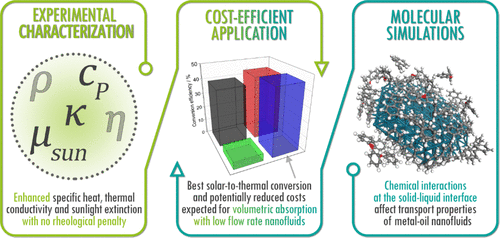当前位置:
X-MOL 学术
›
ACS Sustain. Chem. Eng.
›
论文详情
Our official English website, www.x-mol.net, welcomes your feedback! (Note: you will need to create a separate account there.)
Optical and Transport Properties of Metal–Oil Nanofluids for Thermal Solar Industry: Experimental Characterization, Performance Assessment, and Molecular Dynamics Insights
ACS Sustainable Chemistry & Engineering ( IF 8.4 ) Pub Date : 2021-03-01 , DOI: 10.1021/acssuschemeng.1c00053 Iván Carrillo-Berdugo 1 , Patrice Estellé 2 , Elisa Sani 3 , Luca Mercatelli 3 , Ricardo Grau-Crespo 4 , David Zorrilla 1 , Javier Navas 1
ACS Sustainable Chemistry & Engineering ( IF 8.4 ) Pub Date : 2021-03-01 , DOI: 10.1021/acssuschemeng.1c00053 Iván Carrillo-Berdugo 1 , Patrice Estellé 2 , Elisa Sani 3 , Luca Mercatelli 3 , Ricardo Grau-Crespo 4 , David Zorrilla 1 , Javier Navas 1
Affiliation

|
Concentrating solar power (CSP) technology can become a very valuable contributor to the transformation and decarbonization of our energy landscape, but for this technology to overcome the barrier toward market deployment, significant enhancements in the solar-to-thermal-to-electric energy conversion efficiency are needed. Here, an in-depth experimental analysis of the optical and transport properties of Pd-containing aromatic oil-based nanofluids is presented, with promising results for their prospective use as volumetric absorbers and heat transfer fluids in next-generation parabolic-trough CSP plants. A 0.030 wt % concentration of Pd nanoplates increases sunlight extinction by 90% after 20 mm propagation length and thermal conductivity by 23.5% at 373 K, which is enough to increase the overall system efficiency up to 45.3% and to reduce pumping requirements by 20%, with minimum increases in the collector length. In addition to that, molecular dynamics simulations are used to gain atomistic-level insights about the heat and momentum transfer in these nanofluids, with a focus on the role played by the solid–liquid interface in these phenomena. Molecules chemisorbed at the interface behave as a shelter-like boundary that hinders heat conduction, as a high thermal resistance path, and minimizes the impact of the solid on dynamic viscosity, as it weakens the interactions between the nanoplate and the surrounding nonadsorbed fluid molecules.
中文翻译:

用于热太阳能行业的金属-油纳米流体的光学和传输性质:实验表征,性能评估和分子动力学见解
聚光太阳能(CSP)技术可以成为我们能源格局转变和脱碳的非常有价值的贡献者,但是对于这项技术来说,它可以克服市场部署的障碍,因此可以大大提高太阳能到热能到电能的转化率需要效率。在此,对含钯的芳族油基纳米流体的光学和传输性质进行了深入的实验分析,并有望将其用作下一代抛物槽式CSP工厂中的体积吸收剂和传热流体。浓度为0.030 wt%的Pd纳米板在20 mm的传播长度后在373 K下增加90%的日光消光和在373 K时的热导率23.5%,这足以使整个系统效率提高到45。3%,将抽水需求减少20%,集热器长度的增加最小。除此之外,分子动力学模拟还用于获得有关这些纳米流体中热量和动量传递的原子级见解,重点是固液界面在这些现象中所起的作用。在界面处化学吸附的分子表现为阻碍热传导的避难所状边界,具有较高的热阻路径,并最大程度地减小了固体对动态粘度的影响,因为它削弱了纳米板与周围未吸附的流体分子之间的相互作用。重点介绍了固液界面在这些现象中所起的作用。在界面处化学吸附的分子表现为阻碍热传导的避难所状边界,具有较高的热阻路径,并最大程度地减小了固体对动态粘度的影响,因为它削弱了纳米板与周围未吸附的流体分子之间的相互作用。重点介绍了固液界面在这些现象中所起的作用。在界面处化学吸附的分子表现为阻碍热传导的避难所状边界,具有较高的热阻路径,并最大程度地减小了固体对动态粘度的影响,因为它削弱了纳米板与周围未吸附的流体分子之间的相互作用。
更新日期:2021-03-22
中文翻译:

用于热太阳能行业的金属-油纳米流体的光学和传输性质:实验表征,性能评估和分子动力学见解
聚光太阳能(CSP)技术可以成为我们能源格局转变和脱碳的非常有价值的贡献者,但是对于这项技术来说,它可以克服市场部署的障碍,因此可以大大提高太阳能到热能到电能的转化率需要效率。在此,对含钯的芳族油基纳米流体的光学和传输性质进行了深入的实验分析,并有望将其用作下一代抛物槽式CSP工厂中的体积吸收剂和传热流体。浓度为0.030 wt%的Pd纳米板在20 mm的传播长度后在373 K下增加90%的日光消光和在373 K时的热导率23.5%,这足以使整个系统效率提高到45。3%,将抽水需求减少20%,集热器长度的增加最小。除此之外,分子动力学模拟还用于获得有关这些纳米流体中热量和动量传递的原子级见解,重点是固液界面在这些现象中所起的作用。在界面处化学吸附的分子表现为阻碍热传导的避难所状边界,具有较高的热阻路径,并最大程度地减小了固体对动态粘度的影响,因为它削弱了纳米板与周围未吸附的流体分子之间的相互作用。重点介绍了固液界面在这些现象中所起的作用。在界面处化学吸附的分子表现为阻碍热传导的避难所状边界,具有较高的热阻路径,并最大程度地减小了固体对动态粘度的影响,因为它削弱了纳米板与周围未吸附的流体分子之间的相互作用。重点介绍了固液界面在这些现象中所起的作用。在界面处化学吸附的分子表现为阻碍热传导的避难所状边界,具有较高的热阻路径,并最大程度地减小了固体对动态粘度的影响,因为它削弱了纳米板与周围未吸附的流体分子之间的相互作用。



























 京公网安备 11010802027423号
京公网安备 11010802027423号